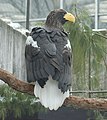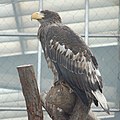This is an old revision of this page, as edited by 76.178.144.66 (talk) at 22:51, 24 April 2011 (punctuation; photo caption). The present address (URL) is a permanent link to this revision, which may differ significantly from the current revision.
Revision as of 22:51, 24 April 2011 by 76.178.144.66 (talk) (punctuation; photo caption)(diff) ← Previous revision | Latest revision (diff) | Newer revision → (diff)
| Steller's Sea-eagle | |
|---|---|

| |
| At San Diego Zoo, USA | |
| Conservation status | |
 Vulnerable (IUCN 3.1) | |
| Scientific classification | |
| Kingdom: | Animalia |
| Phylum: | Chordata |
| Class: | Aves |
| Order: | Falconiformes (or Accipitriformes, q.v.) |
| Family: | Accipitridae |
| Genus: | Haliaeetus |
| Species: | H. pelagicus |
| Binomial name | |
| Haliaeetus pelagicus (Pallas, 1811) | |
| Subspecies | |
|
see text | |

| |
| Orange: breeding only Green: resident all year Blue: winter only Purple: vagrant range. | |
| Synonyms | |
|
Aquila pelagica | |
The Steller's Sea Eagle, Haliaeetus pelagicus, is a large bird of prey in the family Accipitridae. It lives in coastal northeastern Asia and mainly preys on fish. It is, on average, the heaviest eagle in the world, at about 4.9 to 9 kilograms (11 to 20 lb; 0.77 to 1.42 st), but often lags behind the Harpy Eagle and Philippine Eagle in other measurements. This bird is named after the German naturalist Georg Wilhelm Steller.
Description, systematics, and status

Steller's Sea-eagle is the biggest bird in the genus Haliaeetus and is one of the largest raptors overall. The typical size range is 85 to 105 centimetres (33 to 41 in) long and the wingspan is 195 to 230 centimetres (77 to 91 in). Females typically weigh from 6.8 to 9 kilograms (15 to 20 lb; 1.07 to 1.42 st), while males are considerably lighter with a weight range from 4.9 to 6 kilograms (11 to 13 lb; 0.77 to 0.94 st). An unverified record exists of a huge female, who apparently gorged on salmon, having weighed 12.7 kilograms (28 lb; 2.00 st).
Two subspecies have been named: The relatively widespread nominate pelagicus and the virtually unknown H. p. niger. The latter name was given to the population which lacked white feathers except for the tail and supposedly was resident all year in Korea. Last seen in 1968 and long believed to be extinct, a female matching H. p. niger in appearance was born in captivity in 2001. Both its parent were "normal" in appearance, indicating that H. p. niger is an extremely rare morph rather than a valid subspecies, as had already been suggested earlier.
The relationships of Steller's Sea-eagle are not completely resolved. mtDNA cytochrome b sequence data tentatively suggests that this species's ancestors diverged early in the colonization of the Holarctic by sea eagles. This is strongly supported by morphological traits such as the yellow eyes, beak, and talons shared by this species and the other northern sea-eagles, the White-tailed and Bald Eagles, and biogeography.
Distribution and habitat
Steller's Sea Eagle breeds on the Kamchatka Peninsula, the coastal area around the Sea of Okhotsk, the lower reaches of the Amur river and on northern Sakhalin and the Shantar Islands, Russia. The majority of birds winter further south, in the southern Kuril islands, Russia and Hokkaidō, Japan. That being said, the Steller's Sea-eagle is less vagrant than the White-tailed Eagle, usually lacking the long-range dispersal common in juveniles of that species.
The large size (see also Bergmann's Rule) suggests that it is a glacial relict, meaning that it evolved in a narrow subarctic zone of the northeasternmost Asian coasts, which shifted its latitude according to ice age cycles, and never occurred anywhere else. It is unique among all sea eagles in having a yellow bill even in juvenile birds, and possessing 14, not 12, rectrices. The skull and bill are the largest of any eagle and comparable to the largest Old World vultures, the biggest accipitrids.
The birds have been found in North America but this are considered to be individual eagles that have strayed from Asia, and they are not known to nest anywhere in North America.
This species is classified as Vulnerable. The main threats to its survival are habitat alteration, industrial pollution and over-fishing. The current population is estimated at 5,000 and decreasing.

Diet
The Steller's Sea-eagle mainly feeds on fish. Favored prey include salmon (Onchorhynchus spp.), trout and cod. Besides fish, it also preys on water-dwelling birds (including ducks, geese, swans, cranes and gulls), various mammals, crabs, squid and carrion. This eagle has been recorded preying with some regularity on young seals. It is was estimated in one study (Brown & Amaden), that some seal pups carried off by the eagles weighed at least 9.1 kg (20 lbs), which (if true) would be the greatest load carrying ever known for a bird; however the preys' weights were not verified.
Reproduction
This eagle builds several aeries (height, 150 cm; diameter up to 250 cm) high up on trees and rock. It is possible that the eagles change occasionally between these nests.
After courtship, which usually occurs between February and March, the animals lay their first white-green eggs around April to May. Usually only one chick survives. After an incubation period of around 39 – 45 days the chicks hatch, having ash grey to white down. As young birds the down changes to brown feathers and at an age of around ten weeks, the young birds learn to fly. They reach sexual maturity at around four to five years. Full adult plumage in the Steller's Sea Eagle only appears at age eight to ten years.
Eggs and nestlings can be preyed on by arboreal mammals, such as martens, and birds, usually corvids. Once fully grown, the eagle has no natural predators.
Gallery
References
- ^ Template:IUCN2010
- Etymology: Haliaeetus, New Latin for "sea-eagle". pelagicus, "of the open seas", from Ancient Greek pelagos, the ocean.
- ^ Ferguson-Lees & Christie (2001). Raptors of the World. ISBN 0713680261
- http://www.lazoo.org/animals/birds/eagle-stellers/
- Etymology: niger, Latin for "black".
- Kaiser, M. (2010). A living specimen of the dark form of Steller’s Sea Eagle, Haliaeetus pelagicus (“niger”) in captivity. J. Orn. Online. DOI: 10.1007/s10336-010-0580-2
- Davies, E. (2010). Dark Steller's sea eagle solves 100 year debate. BBC Online. Accessed 26 Oct. 2010.
- Wink et al., 1996.
- http://www.wbsj.org/nature/kisyou/eagle/pdf/morphology.pdf
- http://www.arkive.org/stellers-sea-eagle/haliaeetus-pelagicus/info.html
- http://animals.nationalgeographic.com/animals/birds/stellers-eagle.html
- Wood, The Guinness Book of Animal Facts and Feats. Sterling Pub Co Inc (1983), ISBN 978-0851122359.
- http://animaldiversity.ummz.umich.edu/site/accounts/information/Haliaeetus_pelagicus.html
Bibliography
| This article includes a list of references, related reading, or external links, but its sources remain unclear because it lacks inline citations. Please help improve this article by introducing more precise citations. (March 2010) (Learn how and when to remove this message) |
- Brown, Leslie Hilton (1976): Eagles of the world. David & Charles, Newton Abbot. ISBN 0-7153-7269-6
- Ferguson-Lees, James; Christie, David A. & Franklin, Kim (2005): Raptors of the world: a field guide. Christopher Helm, London & Princeton. ISBN 0-7136-6957-8
- True, Dan (1980): A family of eagles. Everest, New York. ISBN 0-89696-078-1
- Wink, M.; Heidrich, P. & Fentzloff, C. (1996): A mtDNA phylogeny of sea eagles (genus Haliaeetus) based on nucleotide sequences of the cytochrome b gene. Biochemical Systematics and Ecology 24: 783-791. doi:10.1016/S0305-1978(96)00049-X PDF fulltext
External links
- BirdLife Species Factsheet. Retrieved 2006-DEC-01.
- Biocrawler.com: Windows Media streaming video showing Haliaeetus pelagicus. Retrieved 2006-DEC-01.
- Photos of Steller's Sea Eagle by renowned nature photographer Klaus Nigge
- Arkive.org: Real Media streaming video showing Haliaeetus pelagicus. Retrieved 2006-DEC-01.
- Natural Research Ltd.: Steller's Sea Eagle Studies. Retrieved 2006-DEC-01.
Categories:


